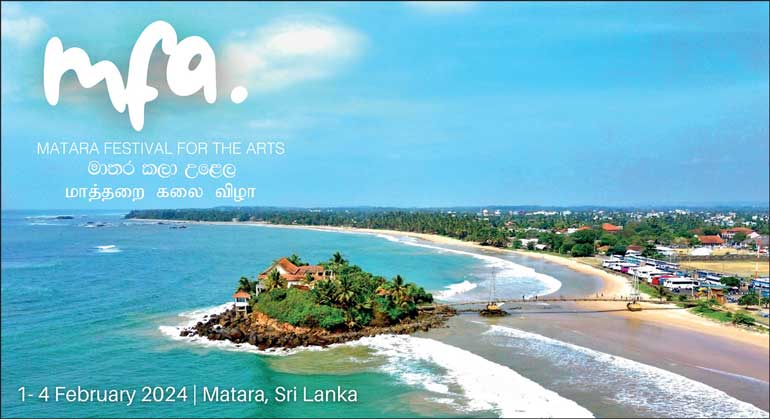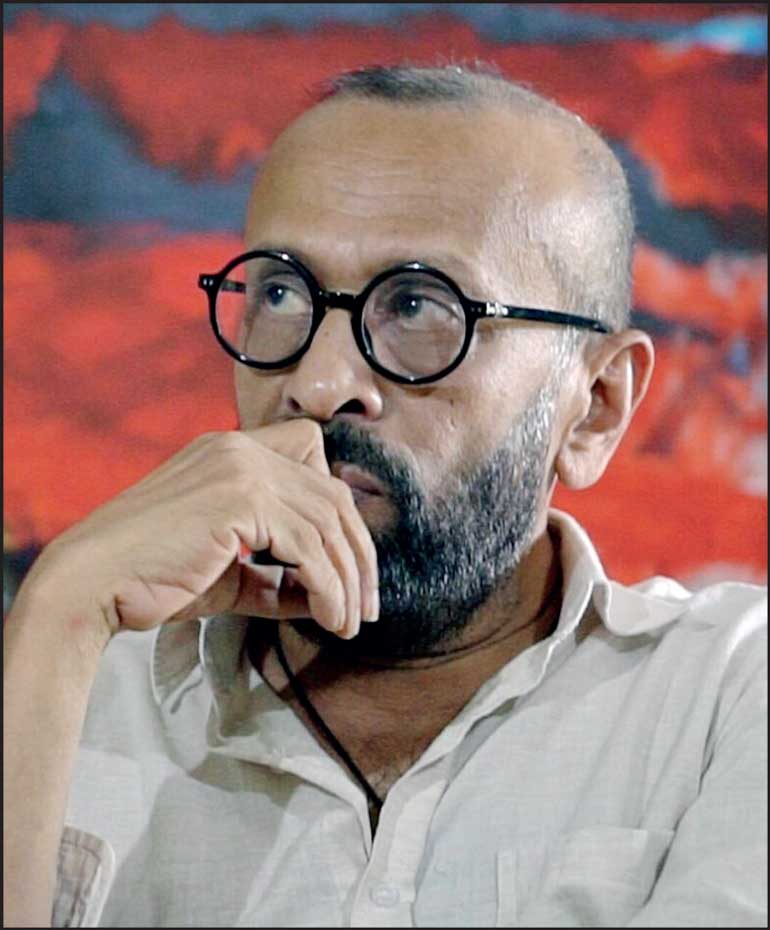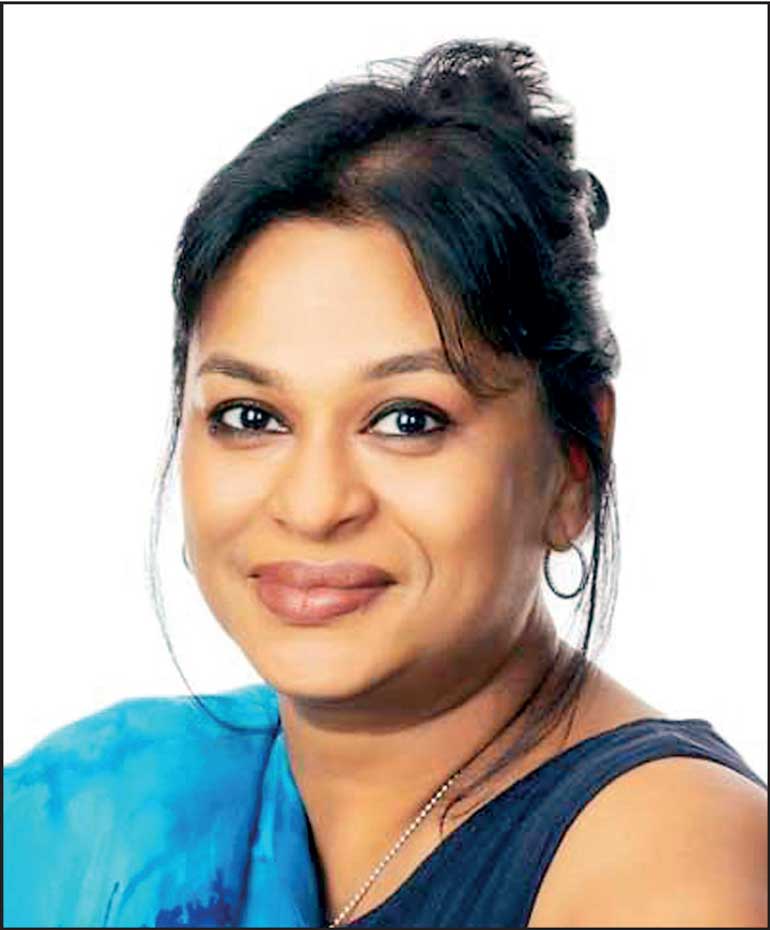Monday Apr 21, 2025
Monday Apr 21, 2025
Friday, 29 December 2023 00:10 - - {{hitsCtrl.values.hits}}

How Matara Festival for the Arts (MFA), from 1-4 February 2024 marks a needed shift for art access beyond Colombo
In conversation with Prof. Jagath Weerasinghe, one of Sri Lanka’s esteemed contemporary artists and archaeologists, and Nadija Tambiah, President – Legal, Secretarial, and CSR (Corporate Social Responsibility) at John Keells Holdings, that has for decades pioneered and sustained a commitment to the development of Sri Lankan arts and culture. They share why they and other art leaders are teaming up to open new horizons of Sri Lankan art – starting in Matara
 |
| Prof. Jagath Weerasinghe |
 |
| Nadija Tambiah
|
Q: What is your understanding/view of the current state of Sri Lankan art and culture both within and outside Colombo?
JW: The contemporary art scene in Sri Lanka to me is dynamic, but only to an extent. On the one hand, interesting shows are happening at private/commercial art galleries, showing works that meet the exhibition-ery scope and desires of art. Yet, one must remember there are other desires of art, such as social engagement, nurturing the notions of sharing and ‘commoning’, etc. The ‘scene’ is also a mostly Colombo-centered phenomenon, built from ‘discovering’ and extracting talent that has already made somewhat of a presence or name for itself or has moulded themselves towards a form that can be more easily integrated into the existing setup. We have comparatively fewer avenues to generate uninitiated talents into the eco-system of art.
NT: I can speak, not as an art practitioner or art expert but from the perspective of a dedicated CSR entity of a Sri Lankan conglomerate - John Keells Foundation, that aims to empower the nation through key development focuses, one of which is Arts and Culture aimed at safeguarding and promoting the cultural heritage and social cohesion of Sri Lanka while enhancing the livelihoods and exposure opportunities of those engaged in arts and culture. Sri Lanka has an incredible depth and talent in the arts and culture sphere. We celebrate our ancient heritage but do not give enough emphasis to the importance of our contemporary culture, especially, our contemporary visual arts. Nevertheless, in the last few years there has been a groundswell of awareness, increasing exhibitions and festivals that showcased how key art is, to telling stories of modern Sri Lanka. Unfortunately, Jagath is correct, many of these exhibitions are staged in Colombo, although most of our artists are in fact not resident in Colombo. It is important to take these conversations to our communities around the Island.
Q: Why is it important to decentralise art, and what challenges may have kept this from happening till now?
JW: Well, it is always better to have more than one hegemonic centre, isn't it?
But let me make the historical rationale for that, if you take a closer look at the current art scene, you will notice that most of the artists who have acquired positions of weight and importance in contemporary art are from the rural and suburban margins. During the early days of Sri Lanka’s ‘90s Trend’ art period, of the last decade of the 20th century and the first of the 21st century, three generative economies, namely the Kala Pola of the George Keyt Foundation, the Vibhavi Academy of Fine Arts, and the Theertha International Artists Collective - gave rise to an art ecosystem that enticed a large number of younger artists from rural and suburban regions to learn, unlearn, and build themselves from an early stage in the world of radical visual arts. You can see these histories in their personal canons and it is exciting.
Yet despite these starts, long-term and increasing support for these approaches has been inadequate, especially in terms of infrastructure investment and informed teaching which includes the contemporary mode. We need more well-equipped institutions addressing art generation early on, thinking of art beyond its exhbition-ery scope. This is the only way we nurture the critical talent that exists at the margins and also see more of what art that gets to flower where it was planted might look like.
NT: Sri Lanka has had a tumultuous 75 years of independence. Much of the shocks we have experienced are due to a lack of social cohesion and our society's inability to remember our recent histories. The arts are probably the most effective medium of engaging in these topics having the ability to record and viscerally showcase the emotions of our society and the impact of these histories. These stories must be told, remembered and discussed by everyone on this Island in order for us to have a sustainable future. Logistically, the country lacks the infrastructure to showcase some of these exhibitions and conversations outside Colombo. It is also important that these conversations take place in all three languages in physical and virtual means to reach a wider audience.
Q: Why Matara? What makes Matara a unique location for an art and music festival? What existing cultural aspects or resources can be leveraged in this initiative?
JW: Well, Matara has been a region that has already given rise to a cultural renaissance in art and literature in the late 18th through 19th century. Think of all those temples with beautiful murals at temples like Kathaluwa Purvaramaya, and Mirissa Samudaragiri Viharaya, then personalities like poetess Gajaman Nona, and the publishing wave fostered by eminent Buddhist monks of the time in the region. Matara has always been an entrepreneurial region with several ancient ports, and the city of Matara, particularly the Fort which housed cinnamon and, as was permissible at the time, elephants for taming and auction.
There is also the Matara that gave us some of the most socially vociferous and culturally creative people in the 20th century Sri Lanka that impacted the course of this island.
I believe Matara is well poised for another cultural revival. And we want to foster it this time with as much local insight and truths as possible, as well as exposure to talent from across the country and beyond.
Q: People often ask but why the arts? Especially as SL is still rising out of a singular economic crisis. How can investing in the arts, leading with the arts benefit Sri Lanka? Is there a regional and international element to this?
JW: You know this question comes from sheer ignorance of the economic potential of the creative industries.
If we look at Korea’s creative economy today, that has defied language boundaries, or looking closer at India, we can see the concrete and soft diplomatic ways art can yield power and create economic value. Sri Lanka has something specific to say, in the world. I think we have given some support to that in fashion, and we are also starting to do so in food, but we are still not seeing beyond the surface of the potential that lies in art.
NT: Most nations in the world have recognised creative economy as the fastest growing contributor to their own GDP. A British Council-commissioned study done by the Institute of Policy Studies in 2020 showed that Sri Lanka’s creative economy increases its GDP contribution by 94% and employs more than 250,000 people. Possibly, more than in the tourism sector.
In many countries, creative industries are the cause of a large portion of their export revenue. Sri Lanka has not yet started realising its full potential in harnessing the power of its creative economy. Creative minds have been recognised as one of the most valuable human skills in the future given the increased use of AI for science and math.
But, creativity needs to be fostered through an ecosystem that includes education, exhibition, museums, festivals and commercialisation. In addition to our mandate to preserve and showcase Sri Lanka’s rich artistic talent, John Keells Foundation support of the arts aims to support this ecosystem that has direct economic benefits for the country.
Q: How is the festival planning to engage and benefit the local Matara community? What are your strategies for ensuring inclusivity and accessibility for diverse audiences?
JW: The festival will place Matara in the cultural calendar of the country. Matara has plenty of moments as a hot-bed of nationalist-southern Buddhist politics. The festival will tell the world that contemporary Matara is much more than that, and that it is actually a cultural centre with high potential.
The Freedom Hub that was started by the late Mangala Samaraweera and revived by our festival director, his niece, started early in laying a generative groundwork by investing in providing cultural exposure programs for youth in Matara, and found there was indeed a demand and an opportunity with this work.
We are now supported by John Keells Foundation, the CSR entity of the John Keells Group, as a principal sponsor of the event. They are a crucial and leading partner to the festival, in building on that opportunity by leading a community art project in October with 8 young artists that will culminate in February with the festival.
The first stage of our work with these young aspirants was to introduce them to contemporary art and expand their abilities beyond well-painted or pretty pictures. This was as much of a process of unlearning as it was learning. Now we are on to creating our collaborative project, with focus duly on recognising one of the most important service providers in Matara, the city cleaners of the Matara Municipality. And it will be a collective piece that you as a visitor can also contribute to.
Q: What infrastructure, resources, or partnerships are needed to sustain the festival's growth and impact beyond the initial event?
JW: I am sure our festival director would say join us now and don’t wait, particularly to other pioneering sponsors. I also think this is an overall signal to invest in Matara but do it with vision and zest, and involve the community. By collaborating and platforming creativity including in new infrastructure projects, there will be a very mutual ecosystem to take the festival onwards, and may show opportunities for other parts of the country as well.
NT: When JKH and JKF are approached for sponsorship support under CSR, we consistently look at the core need the initiative seeks to address, past and prospective impact and long-term sustainability. As Jagath mentioned, the beneficiary community’s support in terms of proactive and sustained engagement is critical; so are progressive awareness building and buy-in of all related stakeholders for which the organisers need to forge meaningful partnerships with local businesses, government bodies, cultural entities including schools and higher education institutions as well as target audiences such as, in this case, artists, visitors and tourists, to ensure these events go beyond one time occurrences.
Q: This festival is the first edition in a city that is also still less familiar with a project like this. Why should people come out, and how can they make the most of this festival?
JW: Art like democracy is a discipline, and so is hope. Hope is a discipline. What I mean by this is that one doesn’t get ‘art’, ‘democracy’, and ‘hope’ by being passive; one has to engage with one’s environment to be culturally informed.
One will have to make a committed decision to come and explore Matara during the festival days. That said there is plenty to entice, including a gathering of Sri Lanka’s leading and rising contemporary artists, and an equally exciting music and speakers roster created uniquely for this event. The festival will of course provide guidance and support to navigate the venues and the city, and I think there are a plethora of options to stay and enjoy along Matara district’s famed coastlines, including special events organised with hospitality partners.
Yet again I reiterate that this is a singular chance that one can be enriched by the democratic nature of art; when art is focused on nurturing and sharing knowledge and hope, art is democratic. There is no other event in the country where one can experience art as an engaging democratic process that intends to bind as many people as possible while respecting notions of difference.